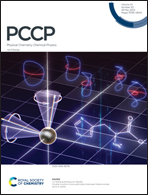Investigation of the mechanical and transport properties of InGeX3 (X = S, Se and Te) monolayers using density functional theory and machine learning†
Abstract
Recently, novel 2D InGeTe3 has been successfully synthesized and attracted attention due to its excellent properties. In this study, we investigated the mechanical properties and transport behavior of InGeX3 (X = S, Se and Te) monolayers using density functional theory (DFT) and machine learning (ML). The key physical parameters related to mechanical properties, including Poisson's ratio, elastic modulus, tensile strength and critical strain, were revealed. Using a ML method to train DFT data, we developed a neuroevolution-potential (NEP) to successfully predict the mechanical properties and lattice thermal conductivity. The fracture behavior predicted using NEP-based MD simulations in a large supercell containing 20 000 atoms could be verified using DFT. Due to the effects of size, these predicted physical parameters have a slight difference between DFT and ML methods. At 300 K, these monolayers exhibited a low thermal conductivity with the values of 13.27 ± 0.24 W m−1 K−1 for InGeS3, 7.68 ± 0.30 W m−1 K−1 for InGeSe3, and 3.88 ± 0.09 W m−1 K−1 for InGeTe3, respectively. The Boltzmann transport equation (BTE) including all electron–phonon interactions was used to accurately predict the electron mobility. Compared with InGeS3 and InGeSe3, the InGeTe3 monolayer showed flexible mechanical behavior, low thermal conductivity and high mobility.

- This article is part of the themed collection: 2023 PCCP HOT Articles


 Please wait while we load your content...
Please wait while we load your content...